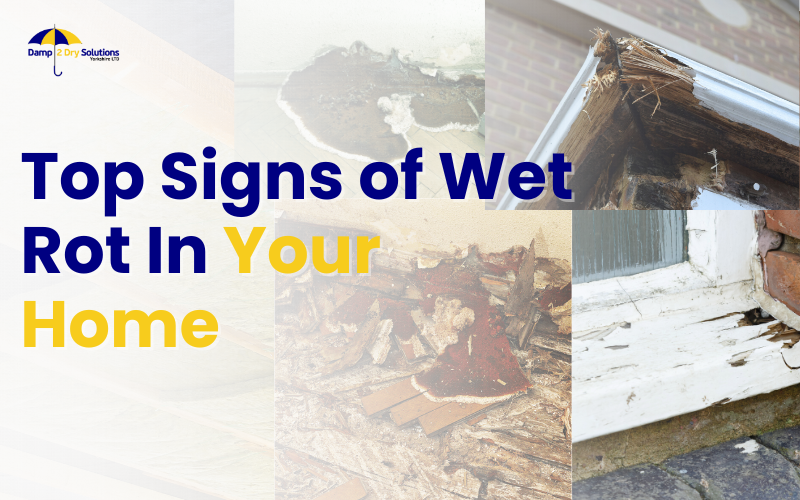Dry rot is a term used to describe the general decay of wood structures in homes, but there are actually two types of fungal rot used under that same name. They are known as dry and wet rot.
The damp conditions that support dry rot also sustain wet rot. Wet and dry rot often occur together, making it hard to distinguish them from one another and making the treatment more challenging. While both types of wood rot can cause significant damage to your home, the dry version is a more serious threat to consider.
Before attempting any repairs, it’s crucial to identify the type of fungus in your household so that you’ll know what steps to take.
Wet vs Dry Rot: What’s the difference between these two types?
Knowing the difference between wet and dry rot is key to preventing expensive repairs and keeping your home safe. Wet rot is more common than dry rot but can still cause severe damage if left unchecked. Both types of rotting occur when fungi feed on cellulose (the natural fibre found in wood) and other plant material, so they’re often confused for one another because of this common trait.
However, wet rot has a few characteristics that help differentiate it from its dry counterpart:
- It spreads faster than dry rot because of water, which helps speed up the process! Even small amounts of moisture can accelerate the damage —meaning water-damaged buildings will likely need more extensive repairs due to this factor alone.
- Wet rot contains spores that can pose a threat not only to your home but also to your health if it comes in contact with humans and pets.
The damp conditions that support dry rot also support wet rot.
Both types of rot need a moist environment to grow. In wet rot, the fungi live in water and feed on organic matter. Dry rot is caused by fungi that live in the air, feeding on wood that’s already dead and decaying.
Wet rot can be found in damp areas like bathrooms and basements where there’s standing water or humidity—both conditions are ideal for the growth of mould spores.
Wet and dry rot often occur together, making the treatment more challenging.
Wet and dry rot often occur together, making the treatment more challenging. Wet rot is caused by water damage and can spread quickly.
While both types of wood rot can cause significant damage to your home, the dry version is more serious.
Dry rot is particularly dangerous because it can spread quickly through buildings and other structures without any signs or symptoms that can remain undetected for a long time. If left untreated, dry rot can be extremely risky and costly to remove.
is wet rot dangerous to health
Generally, wet rot isn’t considered directly harmful to health. However, if you have respiratory issues, like asthma or allergies, you might be more sensitive to the spores it produces. In severe cases, spores from wet rot can sometimes trigger breathing problems, especially in children.
The real danger with wet rot is its effect on your home. Left untreated, it weakens timber, potentially making parts of your home unsafe. While wet rot itself has a low health risk, the damp conditions that cause it can lead to mould growth, which may worsen respiratory issues and allergies.
In short, wet rot isn’t as dangerous as its dry counterpart, you should still take precautions if you suspect some kind of infestation in your home or building. Wet rotted material often gives off an unpleasant, fungal odour —that can travel easily throughout an entire structure! You can read our blog on signs of Wet Rot to know more about it.
Dry rot will eat into your building materials and lead to structural damage.
All wooden structures can be at risk as the dry rot can eat away at floorboards, furniture or even joists. The fungus that causes dry rot breaks down cellulose fibres in timber, leaving it brittle and prone to cracking or breaking apart. The result? Dangerous structural damage and destroyed furniture and walls.
Favourable mediums and plenty of food sources facilitate dry rot spread. Dry rot can spread quickly through buildings, especially if it has an established food source and favorable environmental conditions.
Dry rot typically occurs when moisture levels are low—for example, if there’s been heavy rain or snowfall without sufficient drainage—but can also occur when trees have been exposed for long periods (such as during construction). In these cases, the fungi may eventually penetrate into the timber’s structure so deep that it reaches the heartwood
Dry rot is more dangerous than wet rot because it’s harder to detect when there are no visible signs of disease present on the surface of your walls or ceilings—and once you do find them, they’re likely too late! you can visit on this link to get more info on dry rot early signs.
Conclusion
We hope this article has given you a better understanding of wet and dry rot and some tips for identifying the difference.. in many cases, it will require replacing your entire building’s framework or structural supports.
We have to keep in mind that even though a timber treatment specialist can help remove the fungal growth and repair the damage, if the medium is still favourable, we might be confronted with a reappearance of the dry or wet rot.







